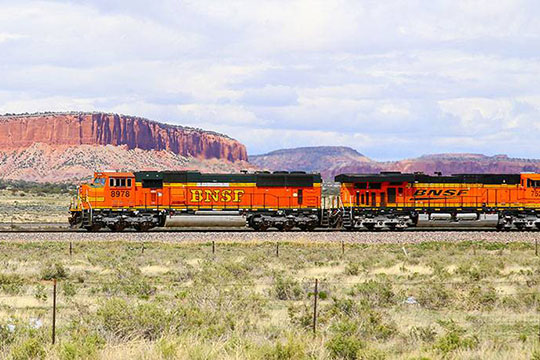All Aboard! NREL Releases First Comprehensive, Open-Source Software for Freight Rail Decarbonization

More than 150 years ago, rail companies built the first coast-to-coast route across the United States: the Transcontinental Railroad. Now, the rail industry has another opportunity to revolutionize transportation. In the coming years, railroads could lay the tracks for industry-wide net-zero-emissions operations—thanks, in part, to a new software tool from the National Renewable Energy Laboratory (NREL).
ALTRIOS, the Advanced Locomotive Technology and Rail Infrastructure Optimization System, is the world's first fully integrated, open-source software designed for exploring deep decarbonization of the rail industry. Now publicly available for download, the tool aims to help freight rail operators transition to clean locomotive technologies and build out associated clean-energy infrastructure in the most cost-effective manner possible.
ALTRIOS was developed by NREL scientists in collaboration with the rail industry and academia and was funded through the U.S. Department of Energy's Advanced Research Projects Agency – Energy (ARPA-E). It simulates real-world rail network operations over the course of decades—allowing researchers to evaluate which clean-energy technology adoption strategies can help rail operators achieve decarbonization targets while minimizing operational costs and scheduling impacts.
"To build ALTRIOS, we worked with industry partners to answer a fundamental question: How can we decarbonize freight rail in an economically viable way?" said Jason Lustbader, a commercial vehicle electrification researcher at NREL who served as the project's principal investigator.
The answer to that question lies in deep collaboration with industry and research partners, paired with world-class modeling and analytics.
Together with BNSF Railway, Southwest Research Institute (SwRI), the University of Illinois Urbana-Champaign, and the University of Texas at Austin, NREL researchers designed ALTRIOS to generate realistic deployment scenarios grounded in actual locomotive performance—both battery-electric locomotives and conventional Tier 4 diesel-electric trains.
A Tool Built With Industry, for Industry
Now, ALTRIOS is the world's first software to combine rail and energy storage technology modeling, train dispatching and corridor simulations, and a high-level train scheduling and routing tool into a single, unified model.
Explore ALTRIOS
Learn more about ALTRIOS, download the full source code, or explore selected capabilities using the web application ALTRIOS-Lite.
The tool was validated using operational data from BNSF and SwRI and can assess the rollout of any energy carriers that could contribute to decarbonized rail operations, including battery-electric, hydrogen-fueled, and biotechnologies.
Importantly, Lustbader explained, ALTRIOS was built to simulate a gradual transition to cleaner technologies.
"Decarbonization won't happen overnight. So ALTRIOS doesn't just illustrate near-term decarbonization strategies," Lustbader said. "It allows us to scale the strategy over time so that, as clean locomotive technologies advance, rail companies can plan to integrate those into their operations and understand the implications for their service."
NREL's advanced modeling and simulation capabilities, the research team explained, were key to developing such a comprehensive tool.
"We incorporated physics-based modeling in key powertrain and train dynamics components to strike a good balance between accuracy and computational performance," said NREL's Chad Baker, who led the ALTRIOS software development. "That gives us a greatly expanded predictive capability compared to a purely data-driven approach, while maintaining a very fast run time and simple configuration."
Baker continued, "It's also what makes ALTRIOS a tool that can create meaningful conclusions about the right combination of infrastructure and technology investments to create net-zero-emission freight transport."
On Track for Transportation Decarbonization
Ambitious federal clean energy goals have called for near-total decarbonization of the U.S. transportation sector—the heaviest-polluting sector of the American economy—by 2050. In turn, North America's largest freight railroads have committed to slashing their greenhouse gas emissions 40% by 2030. ALTRIOS will guide these future decarbonization strategies.
The tool, said Steven Fritz, who leads SwRI's locomotive exhaust emissions characterization activities, is an important start to developing even further open-source modeling tools to help the railroad industry assess their decarbonization options.
"ARPA-E's vision, leadership, and funding set the stage for the project's partners to bring their expertise to bear on this complex challenge," Fritz said. "And we are proud to have brought SwRI's specialties in low-carbon fuels, battery-electric locomotive performance assessment, and locomotive propulsion systems and efficiency to ALTRIOS. We hope to see this innovative tool benefit the public, industry, and our government partners."
NREL researchers have already begun to use ALTRIOS to develop real-world decarbonization strategies. In its first deployment, Lustbader and Baker demonstrated that adding battery-electric locomotives on a BNSF taconite-hauling route could reduce the railway's greenhouse gas emissions.
Now, Lustbader and Baker are applying the software to a Parallel Systems freight decarbonization project that aims to develop autonomous, battery-electric, platooned rail vehicles with flexible routes with the goal of potentially shifting freight from trucks to rail. Because rail can move freight up to four times more efficiently than trucks, projects in a similar vein could realize significant emissions reductions.
ALTRIOS can also be applied to the passenger rail space, where Lustbader notes that there is an opportunity to examine how to deploy new, cost-effective, decarbonized passenger rail projects.
"Throughout the project, we've been able to pull on strengths from multiple organizations and integrate them into a powerful tool—one that I think offers an exciting way to accelerate freight rail decarbonization," Lustbader said. "Now, we're on track to drive down greenhouse gas emissions in cost-effective ways, in ways that make sense operationally, and in support of our long-term national goals."
Learn more about ALTRIOS and NREL's sustainable transportation and mobility research. And sign up for NREL's quarterly transportation and mobility research newsletter, Sustainable Mobility Matters, to stay current on the latest news.
This article has been updated to reflect an editorial change made after its original publication.
Last Updated May 28, 2025
